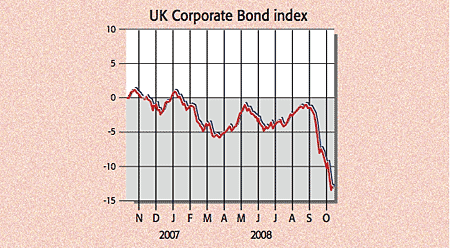
Spooked by the downturn in the economy? The corporate bond market certainly is. Once regarded as a safer place for your money than equities in times of turmoil, this year it’s taken quite a pummelling as credit has dried up and corporate bankruptcy numbers started to soar. Investors, concerned that a growing number of companies will never be able to meet their debt obligations, have pushed the investment grade market (the bonds of the best companies) down 11.5% this year and the junk bond market (the bonds of firms that are recognised to have weak balance sheets) down 19%. At the same time sales of funds in the UK Corporate Bond sector are plummeting – down 23% between July and August alone.
Still, as the price of debt has fallen the yields available have risen. Today, the average junk bond yields a massive 17%, something that – with interest rates around the world on the way down – suggests to many analysts that it might be time to start buying. Is it? Well, the good news is that the default rate on junk bonds was just 3.4% in the 12 months to September. That’s not bad, given that in January 2002 defaults were running at 11.59% and in June 1991 they were 13%, says The Economist. So far, things don’t look nearly as dismal as they have in past downturns. But there’s a problem with this positive thinking: this downturn is only just beginning. As macro-economic conditions deteriorate, so defaults will rise. Yields are high not because bonds are cheap, but because investors are demanding a high return to compensate for the rising risk of holding them. According to Standards and Poor’s, by the end of 2010, 23% of junk bonds trading today will have defaulted. That seems a good reason to steer clear.
However, investment grade bonds may be a different matter. Here, says Simon Surtees of Gartmore, you can get some “very good payback, given the risks involved”. Surtees points to value in investment grade bonds in the financial sector, although investing here might not be to everyone’s taste at the moment. “Sectors such as industrials, telecoms and utilities are all throwing up many good opportunities” as well, says Ian Spreadbury, manager of Fidelity Moneybuilder Income. “For example, BBB-rated industrial bonds are currently yielding 7.9%.”
That’s not bad, and as we’ve pointed out in recent weeks funds such as M&G Strategic Corporate Bond have held steady by avoiding financials. However, Threadneedle Absolute Return Bond, up 8.7% this year, has outshone its rivals because of its ability to switch money between cash, bonds and currencies.